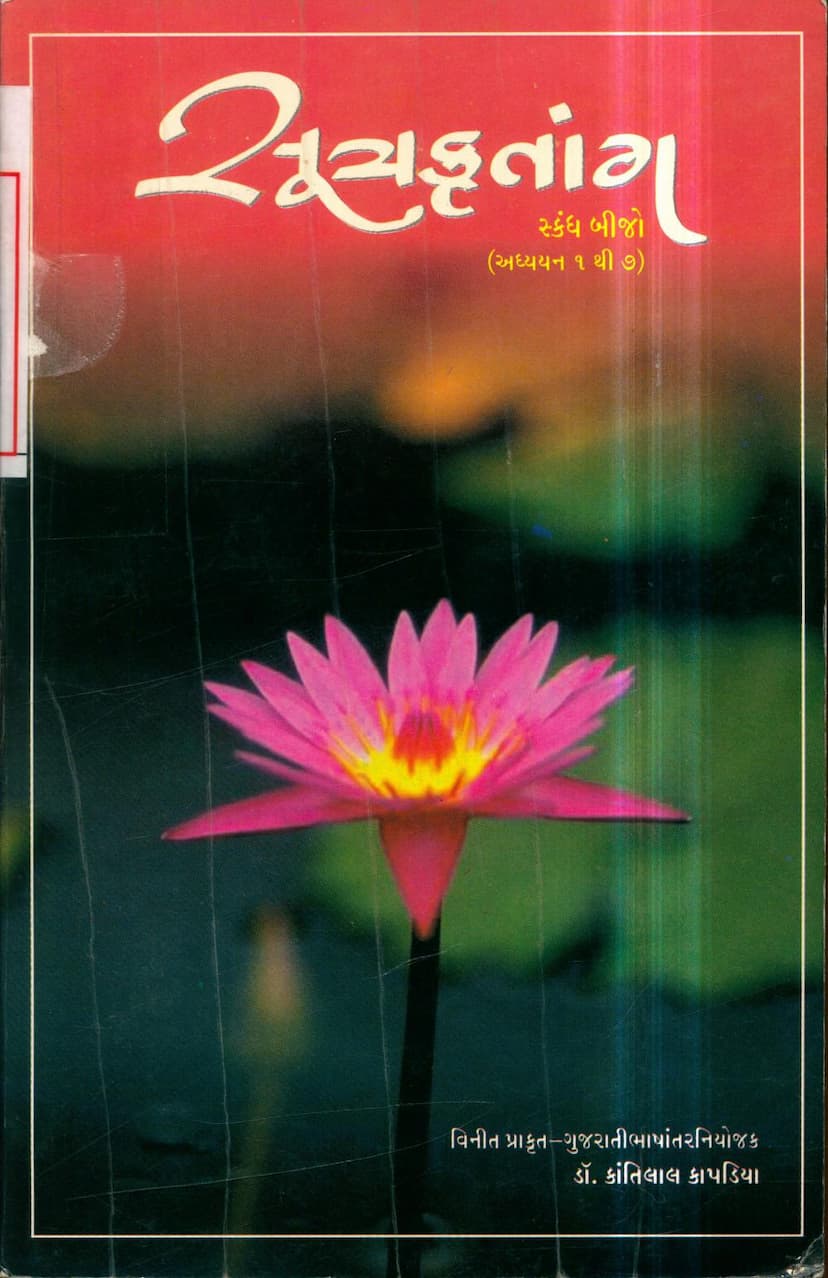Sutrakritang Skandh 02
Added to library: September 2, 2025

Summary
Here's a comprehensive summary of the provided Jain text, Sutrakritanga Skandha 02, based on the Gujarati translation and commentary by Dr. Kantilal Kapadia:
Overall Purpose:
Sutrakritanga Skandha 02, as presented in this text, is the second part of the Sutrakritanga, a foundational Jain scripture. This volume contains seven adhyayanas (chapters) and focuses on explaining the core principles and practices of Jainism, often through allegorical narratives and detailed discussions of various philosophical viewpoints. The author, Dr. Kantilal Kapadia, expresses a desire to make these teachings accessible in modern Gujarati for wider understanding.
Summary of Each Chapter (Adhyayana):
-
Adhyayana 1: Pundarikam (The White Lotus)
- Narrative: This chapter uses the allegory of a white lotus in a muddy pond. Four men, each claiming to be highly skilled and knowledgeable, try to reach the lotus but get stuck in the mud. Finally, a disciplined mendicant, seeing their plight, calls out to the lotus, which then flies up to him.
- Interpretation by Bhagavan Mahavir: The pond represents the cycle of existence (samsara), karma is the water, worldly pleasures are the mud, ordinary people are the other lotuses, the king is the great white lotus, the four men are followers of other sects, the mendicant is the true ascetic, the shore is the path of righteousness, the mendicant's voice is religious discourse, and the lotus flying up signifies nirvana (liberation).
-
Adhyayana 2: Kriyasthan (The Abodes of Action)
- Content: This chapter discusses kriya (action) and its role in karmic bondage. It outlines thirteen types of actions, categorized into those that lead to spiritual downfall (adherence to worldly actions) and those that lead to liberation.
- Key Points:
- Twelve kriyasthanas are associated with the path of adharma (unrighteousness) and are to be abandoned.
- The thirteenth kriyasthana leads to moksha (liberation) and is thus considered good.
- Actions are also classified into three categories: adharma (unrighteous), dharma (righteous), and a mixture of both.
- The first twelve actions result in being bound to samsara, while the thirteenth leads to nirvana.
-
Adhyayana 3: Ahar Pariksha (The Examination of Food)
- Content: This chapter delves into the importance of mindful and controlled eating. It provides detailed information about the six types of living beings (jiva nikaya).
- Key Message: It emphasizes the need for taking food with discernment and restraint, urging monks to be careful about their food intake.
-
Adhyayana 4: Pratyakhyana Kriya (The Action of Renunciation)
- Content: This chapter highlights the necessity of pratyakhyana (renunciation or abstention).
- Key Message: It states that even without explicit pratyakhyana, the act of performing actions that lead to violence incurs karmic sin.
-
Adhyayana 5: Anachar Sutam (The Sutra of Misconduct)
- Content: This chapter defines anachar (misconduct) and provides guidance on speech, beliefs, and conduct.
- Key Message: It exhorts monks to renounce misconduct and adhere to the path prescribed by the Tirthankaras.
-
Adhyayana 6: Ardraijja (Related to Ardra)
- Content: This chapter presents a dialogue between Ardra Kumara and Goshalaka. It also offers insights into the beliefs of Buddhist monks, Vedantists, and ascetics like Hastitapasas.
- Significance: It provides a glimpse into the diverse philosophical and religious landscape of ancient India.
-
Adhyayana 7: Nalanda
- Narrative: This chapter is set in Nalanda, a suburb of the prosperous city of Rajagriha. It recounts the story of a wealthy householder named Lepa, who understood the nature of living and non-living beings. It then describes an encounter between Godwami (an immediate disciple of Bhagavan Mahavir) and Pedhalaputra, a follower of Bhagavan Parshvanatha, at a water pavilion. Later, Pedhalaputra approaches Bhagavan Mahavir, requesting to join the path of five great vows (panchamahavrata) with pratikramana (repentance), moving from a path of four vows. Bhagavan Mahavir grants his request.
- Key Event: The conversion of Pedhalaputra and his acceptance into the Jain fold.
Author's Reflections and Hopes (from the Introduction and Conclusion):
- Dr. Kantilal Kapadia expresses joy in publishing this second volume and his hope that the Gujarati translation will be widely accepted and useful.
- He acknowledges the remaining task of creating a glossary for the entire work.
- He expresses sadness that his wish to translate all Agam Sutras into simple, common languages has not been fully fulfilled.
- Dr. Kapadia emphasizes the need for significant changes in the present era to truly follow Bhagavan Mahavir's teachings, particularly for monks to become true ascetics. He believes actions without understanding are fruitless.
- He advocates for a collaborative effort with Acharyas to determine and implement practices that reflect Bhagavan Mahavir's true message.
- He stresses the importance of translating religious teachings into popular languages for public understanding and, concurrently, studying the old scriptures and Ardhamagadhi language.
- He notes that contemporary sects should align with Bhagavan Mahavir's teachings and expresses that unity is crucial for the advancement of the Shasan (Jain tradition).
- He expresses gratitude to Shri Madhavbhai Bhagwat for the excellent printing work.
- He offers a final prayer and apology for any errors in the translation, mentioning his recent recovery from a health issue and thanking Smt. Anupama Kantilal for her care.
Overall Message of the Sutrakritanga:
The Sutrakritanga, as represented by this volume, aims to guide individuals, particularly ascetics, towards true liberation by clarifying the nature of reality, the consequences of actions, and the principles of right conduct. It critiques various philosophical viewpoints that deviate from the Jain path and emphasizes the importance of self-discipline, mindfulness, and adherence to the teachings of the Tirthankaras. The allegorical narratives, like the white lotus, serve to impart profound spiritual lessons in an easily understandable manner.